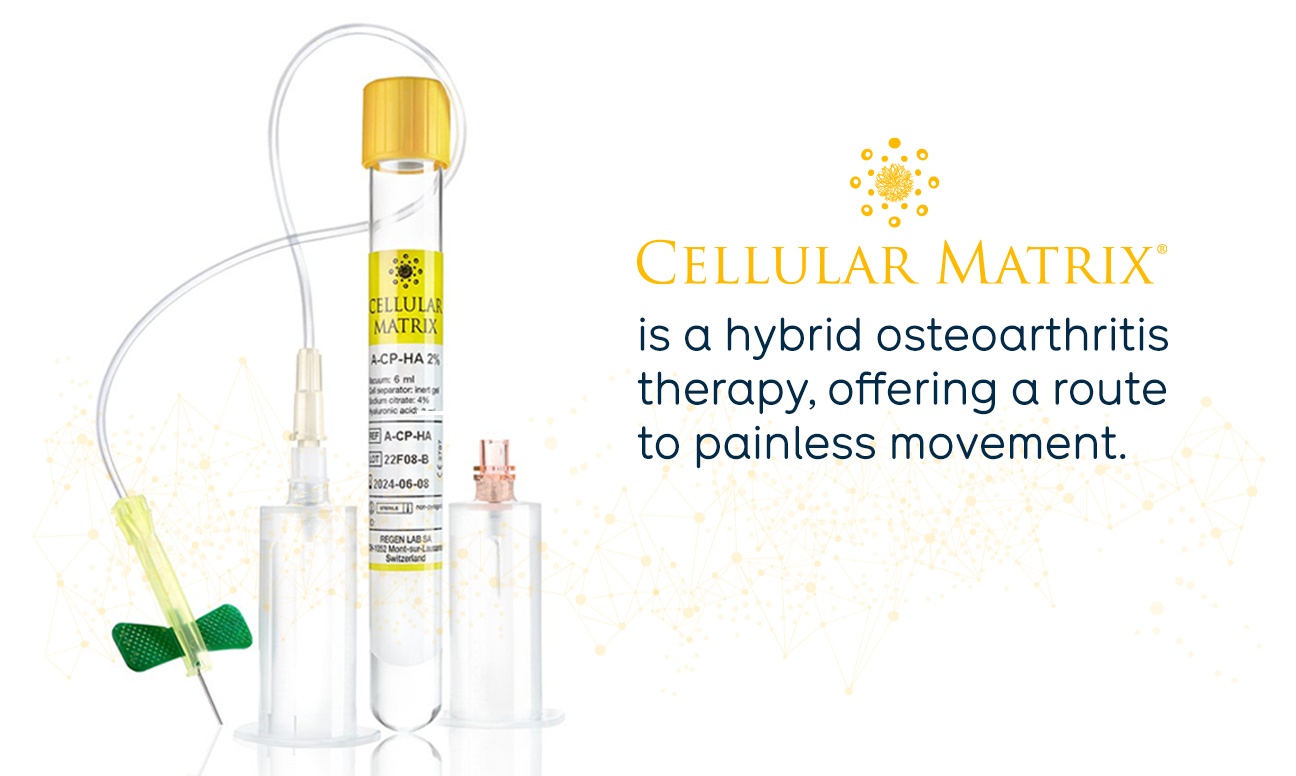What is Osteoarthritis?
It is a typical wear and tear of the joint cartilage. This sickness particularly affects the knee. The abrasion of the cartilage in the knee joint leads to inflammation of the joint capsule. The synovial fluid in the joint becomes thinner and less lubricating with increasing age. This can cause pain. Signs of wear and tear can occur not only in older patients but also in younger patients due to certain risk factors (one-sided strain, too little exercise, obesity, congenital or acquired joint deformities).

What is Cellular Matrix?
Various injection therapies, including PRP and hyaluronic acid, are available for the treatment of pain and mobility improvement in knee osteoarthritis.
Cellular Matrix tubes allow the preparation of autologous platelet-rich plasma (RegenPRP™) combined with a non-cross-linked hyaluronic acid in a closed system.
The Cellular Matrix technology combines the complementary clinical effects of RegenPRP and hyaluronic acid (HA).
The medical device produced in Switzerland is now used in around 60 countries.
For professional use only, to be used by a qualified and trained physician.
What is RegenPRP™?
The patient’s platelet concentrate prepared with RegenKit.
In addition to their role in haemostasis, platelets are key factors in tissue repair mechanisms.1 They provide essential growth factors, such as FGF, PDGF, TGF-β, EGF, VEGF, IGF, which are involved in stem cell migration, differentiation, and proliferation. Platelet growth factors also stimulate fibroblasts and endothelial cells to induce the deposition of new extracellular matrix and neo-vascularisation, respectively.
Plasma contains many factors essential for cell survival including nutrients, vitamins, hormones, electrolytes, growth factors (such as IGF and HGF), and proteins. Among the plasma proteins, the molecules involved in the coagulation process allow the formation of the fibrin polymer that serves as a scaffold for cell migration and new tissue generation.2
What is Hyaluronic Acid?
Hyaluronic acid is an important component of synovial fluid and cartilage.
The most important functions of hyaluronic acid in the joint:
- Lubrication of the joint
- Shock absorption
- Required for fast, low-friction movement
With increasing age, the body’s own production of hyaluronic acid decreases. This changes the composition of the synovial fluid and reduces its elasticity.
What is Osteoarthritis?
It is a typical wear and tear of the joint cartilage. This sickness particularly affects the knee. The abrasion of the cartilage in the knee joint leads to inflammation of the joint capsule. The synovial fluid in the joint becomes thinner and less lubricating with increasing age. This can cause pain. Signs of wear and tear can occur not only in older patients but also in younger patients due to certain risk factors (one-sided strain, too little exercise, obesity, congenital or acquired joint deformities).

What is Cellular Matrix?
Various injection therapies, including PRP and hyaluronic acid, are available for the treatment of pain and mobility improvement in knee osteoarthritis.
Cellular Matrix tubes allow the preparation of autologous platelet-rich plasma (RegenPRP™) combined with a non-cross-linked hyaluronic acid in a closed system.
The Cellular Matrix technology combines the complementary clinical effects of RegenPRP and hyaluronic acid (HA).
The medical device produced in Switzerland is now used in around 60 countries.
For professional use only, to be used by a qualified and trained physician.
What is RegenPRP™?
The patient’s platelet concentrate prepared with RegenKit.
In addition to their role in haemostasis, platelets are key factors in tissue repair mechanisms.1 They provide essential growth factors, such as FGF, PDGF, TGF-β, EGF, VEGF, IGF, which are involved in stem cell migration, di erentiation, and proliferation. Platelet growth factors also stimulate broblasts and endothelial cells to induce the deposition of new extracellular matrix and neo-vascularisation, respectively.
Plasma contains many factors essential for cell survival including nutrients, vitamins, hormones, electrolytes, growth factors (such as IGF and HGF), and proteins. Among the plasma proteins, the molecules involved in the coagulation process allow the formation of the fibrin polymer that serves as a scaffold for cell migration and new tissue generation.2
What is Hyaluronic Acid?
Hyaluronic acid is the most important component of synovial fluid and cartilage.
The most important functions of hyaluronic acid in the joint:
- Lubrication of the joint
- Shock absorption
- Required for fast, low-friction movement
With increasing age, the body’s own production of hyaluronic acid decreases. This changes the composition of the synovial fluid and reduces its elasticity.
Do you have pain in your knee joint?
Preparation in 3 steps in less than 10 minutes

A small amount of blood is taken directly from the vein into a specially developed closed system. The individual blood components are separated by centrifugation. The separator gel forms a physical barrier between the individual components of the blood. The body’s own regenerative elements such as plasma and platelets are separated from the pro-inflammatory elements of the blood. This process takes place in a closed system. Sterile production is therefore guaranteed. The mixture of RegenPRP™ and hyaluronic acid is injected directly into the knee by your physician in compliance with the hygiene guidelines for intra-articular injections.
Contact your physician to find out more about treatment with Cellular Matrix, contraindications and alternative treatment options.
Your physician will also let you know if this is a treatment option for you.
The Cellular Matrix treatment is administered personally by your physician. Cellular Matrix is intended for intra-articular application to the knee joint.
Tips for preventing further joint wear and tear to support therapy:
1- If necessary, you may monitor your weight regularly and maintain a healthy lifestyle. Be sure to discuss this with your physician.
2- Avoid lightning-fast rotational movements or stressful positions
3- Important: Regular exercise, sports that are easy on the joints such as swimming, cycling, hiking, Nordic walking, running and dancing, underwater massages and underwater gymnastics are often beneficial.
4- Contact your physician about the possibility of additional physiotherapy measures

